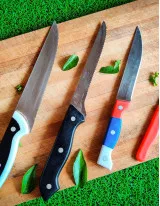Consumer Kitchen Knife Market Expected to Reach $714.35M by 2026
The consumer kitchen knife market share is expected to increase to $714.35 million from 2021 to 2026, and the market’s growth momentum will accelerate at a compound annual growth rate of 6.58 percent, according to Technavio.
Technavio categorizes the global consumer kitchen knife market as a part of the global housewares and specialities market. Our research report extensively covers external factors influencing the parent market growth potential in the coming years, which will determine the levels of growth of the consumer kitchen knife market during the forecast period.
The introduction of consumer kitchen knives with new features is notably driving the consumer kitchen knife market growth, although factors such as high competition from unorganized players may impede the market growth. Technavio researchers analyzed the data with 2022 as the base year and the key drivers, trends and challenges.
The introduction of consumer kitchen knives with new features is one of the key drivers supporting the consumer kitchen knife market growth.
Nowadays, consumer kitchen knives are specifically designed considering the knife weight, the grip of the knife handle, and the sharpness of the knife blades. These are also designed in a way that facilitates easy cleaning, with no scope for food particles to adhere to the knives.
The changing lifestyles of consumers have increased the need for improved kitchen knives that can make routine kitchen tasks easier.
Vendors have analyzed the mechanics behind the movement of hand muscles and the strength required while using kitchen knives for chopping and slicing to manufacture consumer kitchen knives with the correct weight and are offering the same.
Hence, the introduction of consumer kitchen knives with diverse features will attract more consumers, which, in turn, will boost the growth of the global consumer kitchen knife market during the forecast period.
The introduction of consumer ceramic knives is one of the key consumer kitchen knife market trends fueling the market growth. A ceramic is formed through crystallization under extreme temperature and high-pressure conditions. Therefore, ceramic is a dense material that is 50 times harder than steel and second in terms of hardness to diamonds.
A ceramic knife is designed with a ceramic blade that is made from zirconium dioxide. Since these knives are 100 percent stainless, they are not damaged by substances like acids and caustics.
As ceramic knives are lightweight, they can be perfectly balanced and thus reduce hand fatigue during repetitive cutting tasks. Owing to their superior properties, vendors have started offering ceramic kitchen knives.
Such an increasing offering of ceramic knives will propel the consumer kitchen knife market growth during the forecast period.
High competition from unorganized players is one of the key factors challenging the consumer kitchen knife market growth. Unorganized players offer products that are similar in design and look to those of the branded products offered in the market. Since the features of such products are not the same as that of branded products, unorganized players sell their products at a much lower price.
Unorganized retail stores, which are also referred to as mom-and-pop stores, are dominant and capture most of the market in developing countries such as India, Taiwan, and China.
Most unorganized players attract consumers with their low-priced, albeit low-quality offerings. The main advantage for these players is the low operating cost and investment required, which directly creates an impact on the pricing of the products.
Hence, the high competition from unorganized players will hinder the growth of the market during the forecast period.
Thirty-six percent of the market’s growth will originate from APAC during the forecast period. China and Japan are the key markets for the consumer kitchen knife market in APAC. Market growth in this region will be faster than the growth of the market in other regions.
The low penetration of substitutes such as food processors and kitchen shears will facilitate the consumer kitchen knife market growth in APAC over the forecast period.
In 2020, the outbreak of COVID-19 negatively impacted the growth of the consumer kitchen knife market in the region, owing to the imposition of lockdown measures. However, the lifting of lockdown restrictions in the first half of 2021 due to the initiation of large-scale vaccination drives in the region positively impacted the growth of the market.
Moreover, due to prolonged stays at home, consumers look at cooking often as a leisure activity, which has increased the demand for consumer kitchen knives. Thus, such factors will boost the growth of the regional consumer kitchen knife market during the forecast period.
The consumer kitchen knife market share growth by the non-electric segment will be significant during the forecast period. Non-electric consumer kitchen knives are conventional knives that are used at home for various kitchen activities such as chopping, dicing, and slicing fruits, vegetables, and meat.
The prices of these knives vary based on categories. They are made with steel blades and wooden or plastic handles, which are ergonomically designed for perfect grip. Such factors of non-electric knives will drive the consumer kitchen knife market growth during the forecast period.
For news of interest to the kitchenware industry, subscribe to Kitchenware News & Housewares Review.


You must be logged in to post a comment.